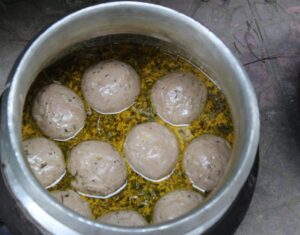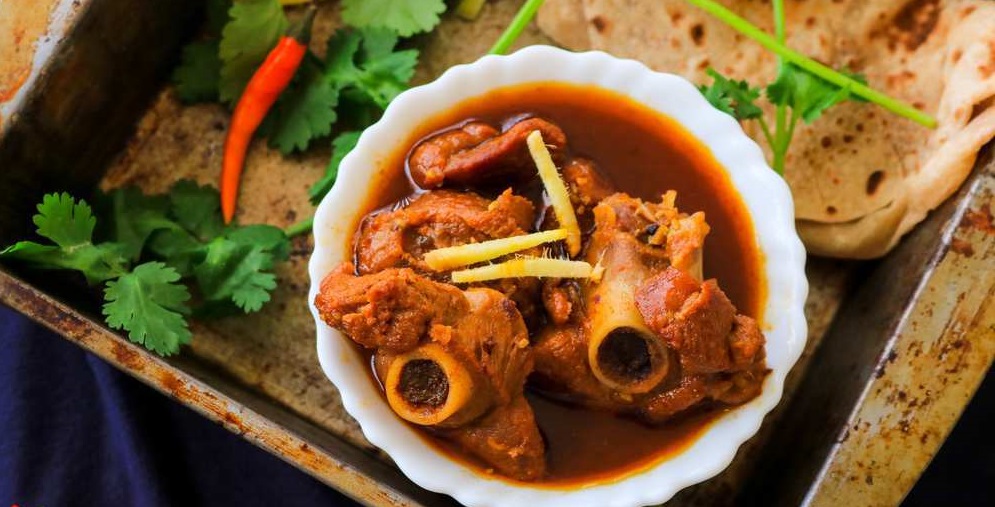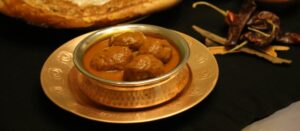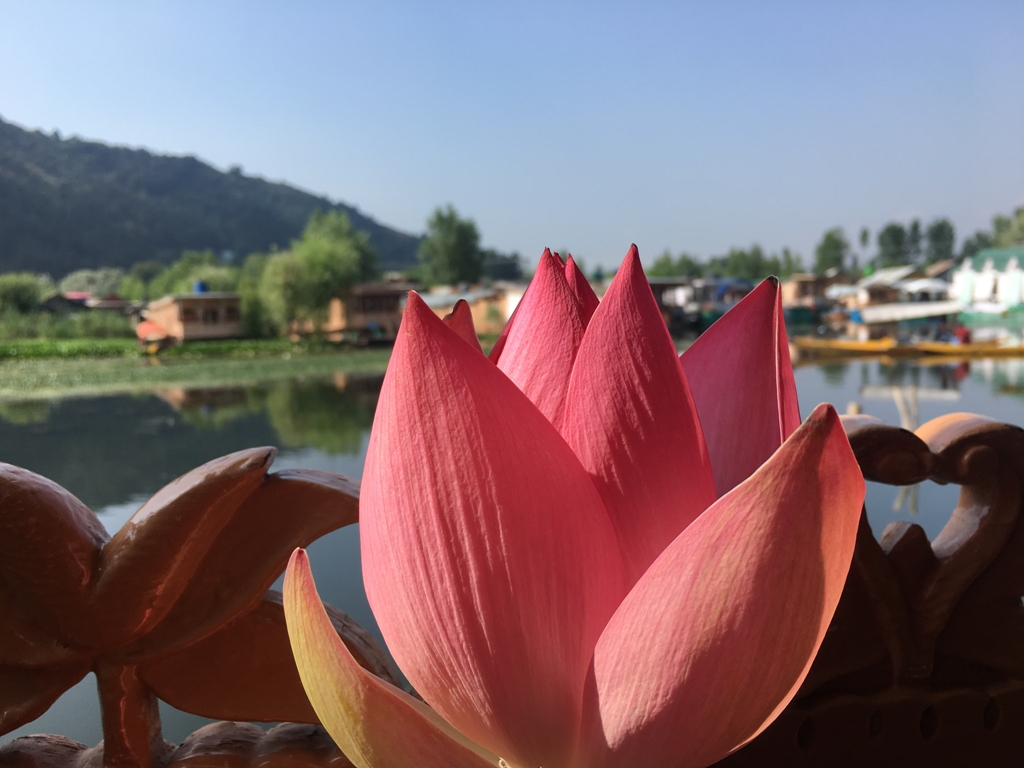Whether it is a houseboat party or a ceremonial marriage feast, Kashmiri Wazwan is not just a meal, it’s an art form, writes Navneet Sahni
Just the other day, I got around to making the “real Dum Aloo” (read Kashmiri style) and I was transported back to the valley in the latter half of the ’70s and the next decade. Living in the valley, especially during college time, one of the most vivid memories was of the meals with fabulous dishes which constitute the grand “Wazwan”. We used to look forward to getting any invite to attend a wedding, or some religious ceremony, a momentous celebratory occasion or simply Raj uncle’s “Dunga” parties on the beautiful Nageen Lake. And if no such invites came our way, the visits to Ahdoos and Mughal Darbar restaurants were the fill-in-the-blank times. These restaurant visits were a stop-gap – to stop the cravings with a dish or two at most, whereas the complete Wazwan was a feast of several courses which would be impossible to get at a restaurant. Believe me, there is nothing as elaborate and tasty as a grand Wazwan. One who has never had a Wazwan feast will continue to believe in the popular adage “One should eat to live and not live to eat”. This will not work if you have eaten this feast of feasts.
Hunger is one of the biggest urges of humans and all religions lay importance to the sacred act of eating. The Hindus give eating a place as sacred as divinity, in Islam one of the names given to Almighty is Razaq – the provider of food. Our sacred texts tell us about Ahuti and Qurbani – offerings to the Gods before eating. Humans have been given the six tastes – sweet, salt, sour, astringent, hot and bitter but it is the sense of smell which is the most important. This in fact has induced mankind to pursue the culinary skills using the local ingredients. Today as we all know this has been elevated to an art form. The Hindu “Shastras” talk about the importance of a bride’s sure-shot way to her husband’s heart – through the stomach. All ancient civilisations have well defined cuisines in some form or the other. Ancient trade routes, like the Silk Route, in fact were established and were greatly influenced by the spice trade.
Origins of Wazwan
There are a few theories to the origin of the “Wazwan” but the most well propounded and plausible is that in the 15th century, the Mongol invader Timur brought this to Kashmir. During his time a lot of arts and artisans moved from Samarkand to Kashmir and that seems to the origins of the “Wazas”– the master chefs in Kashmir. However there is no denying that the Wazwan as we know today has some Iranian, Afghani and some Central Asian cooking methods. The flavours and the mouthwatering dishes of the complete feast make it a meal fit for Royalty. Wazwan consists of multi-course meals with a few vegetarian and mostly non-vegetarian dishes (predominantly mutton dishes).

The expensive feast is now served mostly at Kashmiri weddings, important religious ceremonies and some hotel-organised food festivals. Some say that the original feast consisted of 52 dishes, making it extremely expensive and difficult to prepare. A Vasta (head) Waza may have a few under-training Wazas but it is unheard of to have two head Wazas preparing a feast. In fact in downtown Srinagar areas the availability of a certain Waza determines the dates of the wedding. The training is given by word of mouth to the next generation and there is hardly any authentic cookbook of standard preparations. Each Waza would have his own secret ingredient or recipe. My father told me that it was only once that he had attended a Wazwan with 36 dishes. I have not been to a feast with more than 16 main dishes. Of course, there are several accompaniments to aid digestion of such heavy dishes, mostly chutneys made with onion, walnuts, radish etc. which are served in small pots and are not considered as dishes but sheer accompaniments.
Honing the art
The main ingredient of the Wazwan is mutton (pounded, specific cuts, ribs) and dexterity of the Wazas lies in using different spices like saffron, dried fruits, flowers and accompaniments like fried onions, milk, yogurt, and many other traditional but local flavours to cook it in. This is the art of the Waza and has now acquired a distinctive Kashmiri art form.
Wazwan does not contain non vegetarian dishes only and the notable vegetarian dishes include my absolute favourite Nadr or Nadru (lotus stems) cooked in a yakhni or with the local spinach – Haaq. This big leafy vegetable is absolutely delectable and acts as a perfect foil to the “heavy mutton” dishes. Of course there is a “tamatar tschaman” a tomato-curry-based paneer dish which too is delicious.

Wazwan is definitely an art form. Each Waza grinds or uses his own bought spices, dry fruits, masalas and definitely supervises the cutting of the mutton in pieces suitable for each dish at the butcher itself. It is the red Kashmiri chilies and dried Cockscomb flower powder, called Mawal, which are used to give that rich red-ochre colour. The food is cooked in large nickel-plated copper vessels over dried firewood of a specific tree. The cooking process is actually a long two-day affair – not just because of the number of different dishes or that some dishes require to be cooked on a slow fire, but also the fact that with time a particular dish acquires a distinctive taste.
All cooking is done under the direct supervision and guidance of the Vasta Waza. Just imagine, hundreds of kilos of meat have to be cooked in several dishes – to perfection. The kitchen is open-air and is generally a 10–15 feet long brick and stone fire-place. Fire-wood is used as fuel. Heat of such fires is very easily regulated for mass cooking. This is the skill of these Wazas and they ensure that strict traditions, and instructions have to be followed to the hilt ensuring only specific utensils only which can be used – again approved and supplied by the Waza himself. There are specific people who are meant to pound meat to paste of an exact consistency using a wooden mallet and the tree trunk of a specific tree. Just imagine hundreds of kilos of mutton is pounded as two of the signature Wazwan dishes – the Rista and the Gushtaba is made using this pounded meat. Another example of tradition is the Tasht -i- Naer – a copper wash basin and a copper jug used to wash your hands after you are seated on the ground to eat. The Waza usually accompanies this ritual. This has not changed for generations – perhaps to introduce the Waza himself to the guests.
The food is served in a large copper plate called the Trammi. Any 4 people share this plate and is served heaped with rice and is semi pre-plated. A few dishes like the Tabak Maaz, Methi Maaz, and the Seekh Kebab come with the Trammi. Hence forth the meal is consumed in a specific order and the Waza will himself serve it from a massive vessel. Starting from the pre-plated dishes the Waza will serve it course by course and follow it up with the Rista, furthermore with some more meat items, such as Rogan Josh. The finisher of the Wazwan is the Gustaba – a large round meatball (otherwise joking referred to as the full stop)!
Famous dishes
Some of the famous dishes (mostly all in mutton but cooked in different flavours and ingredients) are:
Rista: Pounded to a certain consistency and mixed with some meat fat, these round meatballs come with a delicious red curry. These are served individually to each person and are small in size. It is one of the two signature pounded meatball dishes.
Rogan Josh: A superb mutton dish whose preparatory styles are hotly debated by amateur and professionals alike. Cooked in just oil and spices and lots of red chilli powder (which gives it a red colour) this is an absolute favourite of all and sundry. The colour of the dish comes from Kashmiri red chillies and Mawal which is all colour and not hot at all. Contrary to what most people think, that it is just another mutton curry, the reality is that the meat has to be marinated for at least 2- 4 hours before cooking.
 Methi Korma: A unique and tasty dish which has a very loyal following. This is a curry made in methi leaves and the stomach lining of the goat. The cooking of this dish signifies the dexterity of culinary art of the Wazas.
Methi Korma: A unique and tasty dish which has a very loyal following. This is a curry made in methi leaves and the stomach lining of the goat. The cooking of this dish signifies the dexterity of culinary art of the Wazas.
Tabak Maaz: Another signature dish – the Tabak Maaz are deep (but slow) fried ribs that are then slow cooked in some yogurt with several spices till tender. It has no curry and is a dry dish. An absolute must is to get the rich texture and spices, and it is just fabulous to taste.
Yakhni: This is a distinctive type of cooking and just not a dish. It can be prepared with mutton, lamb, chicken, or even lotus stem, and all dishes are signature Kashmiri dishes. It is a dish cooked in yogurt and spices but without chillies. The simple and different taste of this dish actually neutralises the very heavy flavoured dishes served earlier.
Gushtaba: This is another signature meatball dish and signifies the end of the feast. Cooked in yogurt and spices this helps in digesting the several heavy dishes consumed earlier. It is quite similar to the Rista (red curry) but is less spicy and the yogurt aroma is really appetising. While both are made of pounded meat paste, the difference is the size of the meatballs and the curry it is cooked in. Gushtaba is usually a large meatball and is served 1 per trammi which is enough for all four. It is not unusual to have a Gushtaba of about 250 gms or more.
Two variations
Around the time this traditional cooking style came to Kashmir, the area was overwhelmingly Hindu and so there came about two variations of the feast – the Wazwan (Muslim) and Wazwoor (Hindu). Unlike the Wazwan, the large Hindu food gathering is commonly known as Sal. The Kashmiri Pandits cooking is done mostly in earthen pots of baked clay. The clay Deg is used for all types of vegetarian and non-vegetarian cooking and imparts a special flavor and taste to the dishes. Thus the taste, spices and cooking style is quite different from Wazwan. Another big difference in the Pandit cooking is the use of more vegetables, paneer and fruit in their cooking.
Kashmir in those days was a Sharda Peeth – a seat of learning and Kashmiris were strict followers of the Shastras, mostly Brahmins who followed strict guidelines. In fact Kashmir got its name from Rishi Kashyap. With detailed knowledge and medicinal and aromatic values of all spices (local or imported) the Pandit cooking relies very heavily on these in their cooking style. This is another very important difference in cooking styles as the Wazwan rely heavily on shallots (Pran as it is locally called), onion and garlic. The Pandits did not use these till very recently and use a lot of asafoetida (hing) to flavour food as well as dried ginger and crushed fennel (saunf) powder. There are hardly any common dishes between the two cooking styles apart from maybe the all-time favourite, the Rogan Josh. Even this differes in style of preparation. The Muslim style involves boiling of the meat in oil and masalas, where as the Hindu style involves braising. Neither of the two styles involves tomato, something which restaurants across India use predominantly. Similarly very little chillies are used and instead they use the Mawal (cockscomb powder) to give the dishes the red colour. The Pundit Sal does not have Rista or Goshtaba or for that matter Tabak Maaz but instead has one of the yummiest mutton dishes – Matsh. This and the absolutely amazing Dum Aloo (please see recipe I learnt from a master chef) can easily be their signature dishes. Frankly, both cuisines are simply lip-smacking and no other feast comes even close.
The other difference is that while the Wazwan is eaten by four people using a Trammi, the invitees at a Sal use individual bronze plates. The common thing is that in both feasts invitees sit on the floor and are served rather than self helping.
Sweet endings
For the dessert the only sweet (usually) in Wazwan is the Phirni followed by a cup of Kahwa, the Hindus’ favourite is the Modur Pulav (a sweet rice infused with saffron, dry fruits, cardamoms and other exotic spices). Apart from this, you do have different types of Halwa or Firni too. Kahwa is a hot favourite with anyone and everyone as it helps digestion.
These feasts are now no longer served during marriage festivities or such occasions indoors, but also for picnics and general occasions too. There are three very distinct types of venues which I have enjoyed immensely partaking Wazwan. These are etched in minds of most Kashmiris. The most enjoyable without a doubt is a dinner “Dunga Party”. A small rustic houseboat usually with no partitions and large windows is moored to the banks of the Dal or Nageen lake and awaits all guests. Once all arrive and are seated (on the wooden floor with exquisite carpets) the boat is rowed slowly. The spicy aroma of food, being cooked in the small kitchens (some larger Dungas have that) wafts across. Sufiyana music is the perfect accompaniment (I am sure this is where the term Lotus Eaters came from as it is magical) as you hear the soft strains of Sitar, Saz, & Tabla. Once the party gets boisterous the Chakkri songs start with impromptu dancing. The Tumbaknar (an indigenous Kashmiri one-sided drum) heats up the evening even more, eventually culminating in the Wazwan being served. The entire evening is at least a 4 – 5 hours affair. In those heady days the youngsters would smuggle many beer bottles not realising that there were no facilities on board. Eventually the lake got polluted a little. I wish Kashmir could return to those times!
The other memory I have is that of the annual picnic outing at the Badamwari. This festival celebrating the almond blossoms is also the Kashmiri New Year. The main venue is on the gardens below the imposing Hari Parbat in downtown Srinagar. Some date this garden to the reign of the Sultan ZainUl Abidin (14th century) and so it seems that it is such an old tradition. Heralding spring, the people of all strata come out in droves and it becomes difficult to find an inch of space. Family gatherings have to involve food and what better than a Wazwan in those settings! I remember that it was a treat to see the best of samovars from all over from which large quantities of flavoured Kahwa was drunk. These samovars are heirlooms and come out on these types of occasions.
Finally, I have attended many weddings – some of known and some of unknown people. Such was the gracious hospitality of Kashmiris that the host who may be a relative of friends would welcome us warmly, knowing fully well that we were there only for the meal. Sadly, those times will never return and will remain very pleasant memories only.
Recipe for the authentic Kashmiri Pandit style Dum Aloo
Take 10–12 equal sized potatoes and parboil them (two whistles of the pressure cooker is enough)
After they cool down, peel them and let them rest for 10 minutes
Take a toothpick (note I am not suggesting the use of a fork as it does not serve the purpose) and poke several holes across the potato. This step is very important as the tooth pick must go right through to emerge at the other end. This will make sure that it gets fried through and imbibe the spiced curry for a uniform flavor.
Deep fry the potatoes till they are dark golden brown. (A tip is to refry the potatoes so that they become crisp). Use good mustard oil only.
Use the remainder of the oil (or part of it) to make the curry:
Take 4 green cardamoms, 2 black cardamoms, an inch of cinnamon stick, 5 whole cloves, 3 bay leaves, and about 10 whole black peppercorns in a mortar, and roughly pound with a pestle.
Heat the oil again and reduce the flame to low when you add the above pounded spices to the oil. Let it sizzle for about 30 seconds (make sure it does not burn the spices – but just enough to bring out the flavours).
Add 3 spoons of Kashmiri red chilli powder, salt to taste, ¾ spoon of dried ginger powder, 2 spoons of dried fennel (saunf) powder to the pan where by now the whole spices would be giving a fantastic aroma. Stir for another 30 seconds, add half a spoon of garam masala and the potatoes. Stir a while so that the thickened oil curry covers the potatoes evenly. Let this be over a mid-flame for about 60 seconds.
Add 1 tea cup of water to the pan and close the lid for about 2 minutes. The master chef I got this recipe from did not use the water but had used a lot of oil and Mawal (he did suggest this can be done also). The curry was left to simmer for about 5 minutes over a very very low flame. You will see that the potatoes by now have been covered in oil and the curry, and will be red in colour from the chilli powder. Do not be alarmed if the curry has become thick or even disappeared. The potatoes soak up nearly all water and so using a heavy hand for oil, the more the better, is recommended (after all, you will die only once). In Delhi it is not easy to get genuine Mawal so I am wary of using it.
Your lip-smacking Dum Aloo is ready. It is best served on a bed of rice and enjoyed eating by hand.








